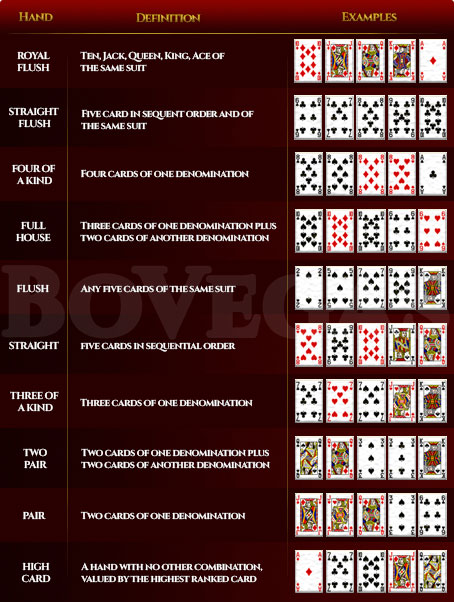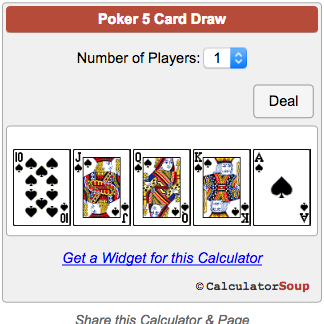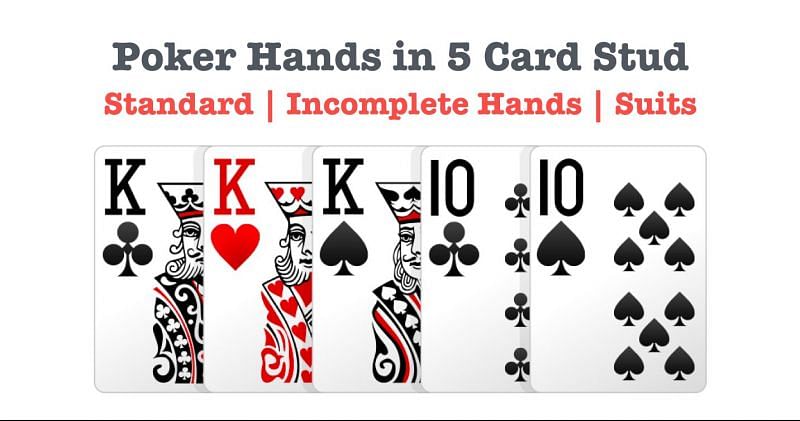5 Draw Poker Hands
Table Of Contents

One of the simplest variants of poker, and one that is many poker player's first introduction to the game of poker, is 5-Card Draw.
Premium pairs in five card draw are aces, kings and queens. These are all strong hands that will win you a lot of money in the long run. There is however a time and a place for each of these three hands. A pair of aces can be played from any position at the table. Five card draw is one of the oldest forms of poker, which emerged in New York salons with the outbreak of the Civil War. Today, it remains popular with all on the internet, thanks to our version of 5 card draw online, recommended especially for novice poker players. Five card draw is only up to two hands.
More common in home games than it is in casinos, 5-card draw has been overtaken in the popularity by games such as Texas hold'em and Omaha poker.
But there are still plenty of 5-card draw fans around the world — particularly in the online world where several online poker sites offer cash games and tournaments.
Free Bonus to Play 5-Card Draw OnlineActivate this no deposit offer to play free 5-card draw games online!
How to Play 5-Card Draw Poker
If you have played any other form of poker, 5-card draw rules are similar in that the aim of the game is to make the best five-card poker hand.
Like Texas hold'em, the poker hand rankings, from weakest to strongest, are as follows:
- High card
- One pair
- Two pair
- Three-of-a-kind
- Straight
- Flush
- Full house
- Four-of-a-kind
- Straight flush
- Royal Flush
When it comes to preflop betting, there are two different methods used in 5-card draw.
Either all players pay an ante before receiving their cards (this is more common in home games), or there is a small blind and big blind similar to hold'em and Omaha games (this is the most common on online poker sites and in casinos).

Three different betting structures exist for 5-card draw, too.
You can play 5-card draw poker as:
- Fixed-limit
- Pot-limit
- No-limit
While all three formats play to the same poker rules, the different betting structures mean your strategy needs to be adapted.
For example, some hands that you wouldn't play in fixed-limit 5-card draw become playable in no-limit 5-card draw because in the latter you can bet enough to force your opponent to fold.
Regardless of the betting structure, this is how to play 5-card draw.
Five-Card Draw Basics
Once everyone has paid the ante or the blinds, each player receives five cards face down.
A round of betting then occurs.
If more than one player remains after that first round of betting, there follows a first round of drawing.
Each active player specifies how many cards he or she wishes to discard and replace with new cards from the deck.
If you are happy with your holding and do not want to draw any cards, you 'stand pat.'
Once the drawing round is completed, there is another round of betting.
After that if there is more than one player remaining, a showdown occurs in which the player with the best five-card poker hand wins.
As you can see, the rules for 5-card draw are simple and make for a fast-paced game, which is why the game is popular with new, less experienced players.
Basic 5-Card Draw Strategy
The fact you can learn how to play five-card draw poker in a few minutes doesn't mean that you will not need to practice to go from beginner to pro.
The best way to do that, is to practice online — possibly with some free games. If you have a few minutes to try a game or two, have a look at 888poker.
You can play with a no deposit bonus on signup that you can use to discover 5-card draw poker and master all the basic and advanced strategy tips that follow.
One trap lesser-skilled 5-card draw players often fall into is playing far too many hands, particularly hands drawing to a straight or flush.
In many cases, the saying 'tight is right' applies when it comes to starting hand selection in 5-card draw.
As in games with community cards, your position in relation to the button is also important in 5-card draw poker.
The closer to the button you are, the wider the range of hands you can play profitably.
Regardless of your position, you should almost always enter the pot with a raise because limping in usually results in several other players limping behind, which in turn means you need a much stronger hand to win the pot.
Play tight from early positions and raise with hands such as aces or kings.
As your position improves, you can add other high pairs such as queens, jacks, tens, and nines, so long as the latter has a good kicker to back it up.
Those of you fortunate enough to have been dealt two pair or three-of-a-kind should always come out raising whether you're under the gun or on the button.
Meanwhile be wary of holdings such as four to a straight or flush, because these are hands with which some players bleed away their bankroll.

With one card to come, you're around a 4-to-1 underdog to hit your hand, and often you won't have the correct pot odds to attempt filling your straight or flush, particularly in a short-handed game.
What Should I Discard in 5-Card Draw?
Knowing what cards to discard during the drawing round is what makes and breaks a 5-card poker player.
On a basic level you should consider the following:
| What you hold | What you should do |
|---|---|
| One pair | Draw three cards |
| Two pair | Draw one card |
| Three-of-a-kind | Draw two cards |
The above list is only scratching the surface of what you should draw in 5-card draw. Adhering to it, particularly in low-stakes games, should yield positive results.
Advanced 5-Card Draw Strategy
Once you have a grasp of the basics and are feeling more confident with how to play 5-card draw, you can start applying some more advanced strategies to your game.

There is a large psychological element to 5-card draw thanks in large part to the drawing element of the game.
For example, while it is statistically the best play to draw three cards when you hold a pair, if you always make this play your opponents will be able to read your hand easily and alter their strategy to defeat you.
You need sometimes only to draw to one or two cards with a pair in your hand — or even to stand pat — in order to represent a holding stronger than what you actually have.
Unlike in games such as hold'em, there is rarely any stone cold bluffing in 5-card draw.
Players usually have at least a playable hand when betting even if they are indeed bluffing. This is why it is vitally important to take detailed notes when playing 5-card draw because they are extremely helpful.
Should you make a note that a player only opens with a pair of jacks or stronger on the button, you can easily fold a pair of nines in the blinds instead of calling.
Where Can I Play 5-Card Draw Online
As mentioned at the start of the article, 5-card draw is not a game that enjoys as much popularity as the likes of hold'em, but there are quite a few websites where you can play 5-card draw online.
The safest option is to try one of three sites below and play some games there.
These poker sites are your best bet for finding both 5-card draw cash games and tournaments at a variety of limits.
It is also possible to hone your skills at the play money tables there and play 5-card draw online poker free of charge with no risk to your bankroll.
The Best Five-Card Draw Sites OnlineFind the best games and play 5-card draw online for free or real money. The first bonus is on us!
'>Photo: Flush Poker Hand - Hearts, Guts Gaming. Creative Commons Attribution 2.0 Generic.
Tags
cash game strategytournament strategyfive-card drawother gamesbeginner strategyrules
Raise First In
Our Objective
Our primary focus when playing 5-card draw should be attempting to make three-of-a-kind. We look for decent pairs and then draw 3 cards hoping to make trips. Drawing three gives us statistically the highest chance to make trips. You will often see players at your limit holding on to one of their kickers and drawing only two cards, but in most cases this is incorrect.The exception is that there are already 2 limpers in the pot, in which case it's fine to limp behind some straight-draws and flush-draws, but gut-shots should typically be folded. We don't want to make hard and fast rules here but there are some exceptions vs passive opponents where we can get away with cold-calling these hands for one of the two following reasons in a no-limit-game
- Our opponent just can't fold at showdown and hence we have great implied odds. (Note that this applies purely to no-limit 5-card draw games and it's nearly always going to be a mistake to call a raise preflop with a straight-draw or flush-draw in a limit game)
- Our opponent plays extremely face up on the final street and we can pick up pots as a bluff. (Note that again this applies more frequently to no-limit games as our opponent is less likely to fold anything to a min-bet in a limit game)
RFI Ranges
- UTG KKxxx+
- MP QQxxx+
- CO JJxxx+
- BTN 99xxx+
- SB TTxxx+ (however it's OK to complete some weaker hands with reasonable potential)
Isolating
Pairs lower than JJxxx are referred to as “shorts” and are generally considered trouble hands in 5-card draw, so play with caution. These should often be folded preflop, but again it is somewhat villain dependent. We might be able to play some smaller pairs as limp-behinds and take the opportunity to turn them into a bluff on the river vs face up opponents.
The Draw
- If we have a pair we draw 3 and try and make trips.
- If we have trips, we draw two and try to make Quads or a boat.
- If we have a flush-draw or straight-draw we draw one and try to hit.
- If we have total garbage (usually in a free play situation) we can hold on to cards above a Queen or Jack and replace the others.
Hand Reading
5 Draw Poker Hands
3 cards – In most cases this will indicate that the player has a pair and is trying to pick up three-of-a-kind. A very bad player might be drawing to a flush or straight with only 2 cards. It's always worth taking a note of this kind of thing if you discover at showdown that the player drew 3 cards and does not even have a pair when he shows down.
Showdown
Advanced Tactics
Our opponent will often call with 2-pair in this situation hoping to either beat our 2-pair or bluff-catch against our busted draws. In other words, drawing 1 allows us to represent a weaker range with a strong hand. Note that this only makes sense against semi-decent opponents. The average fish may not even care how many cards we draw, in which case we should always draw 2 with trips and give ourselves the maximum chance of improving.
Our opponent will usually fold unless he improve to trips or better. And even if he has trips it won't theoretically be a correct call unless he expects us to be bluffing like this since we are representing a 5-card hand which beats his trips. Obviously we have to be careful not to over-use this line. If we stand-pat every hand it's going to become obvious pretty quickly that we don't have anything.
Using Position to Bluff
- They would lead for value if they hit a strong draw
- They would lead for value a decent amount if they had 2 pair
- It's overall pretty unlikely that they'll spike their draw
So if our opponent has a tendency to go for hugely unlikely draws then we can defend much wider in position even with some weak hands ourselves. We might not get the pot-odds to defend the hand, but if our opponent simply check folds final-street every time he misses, our preflop odds don't matter.